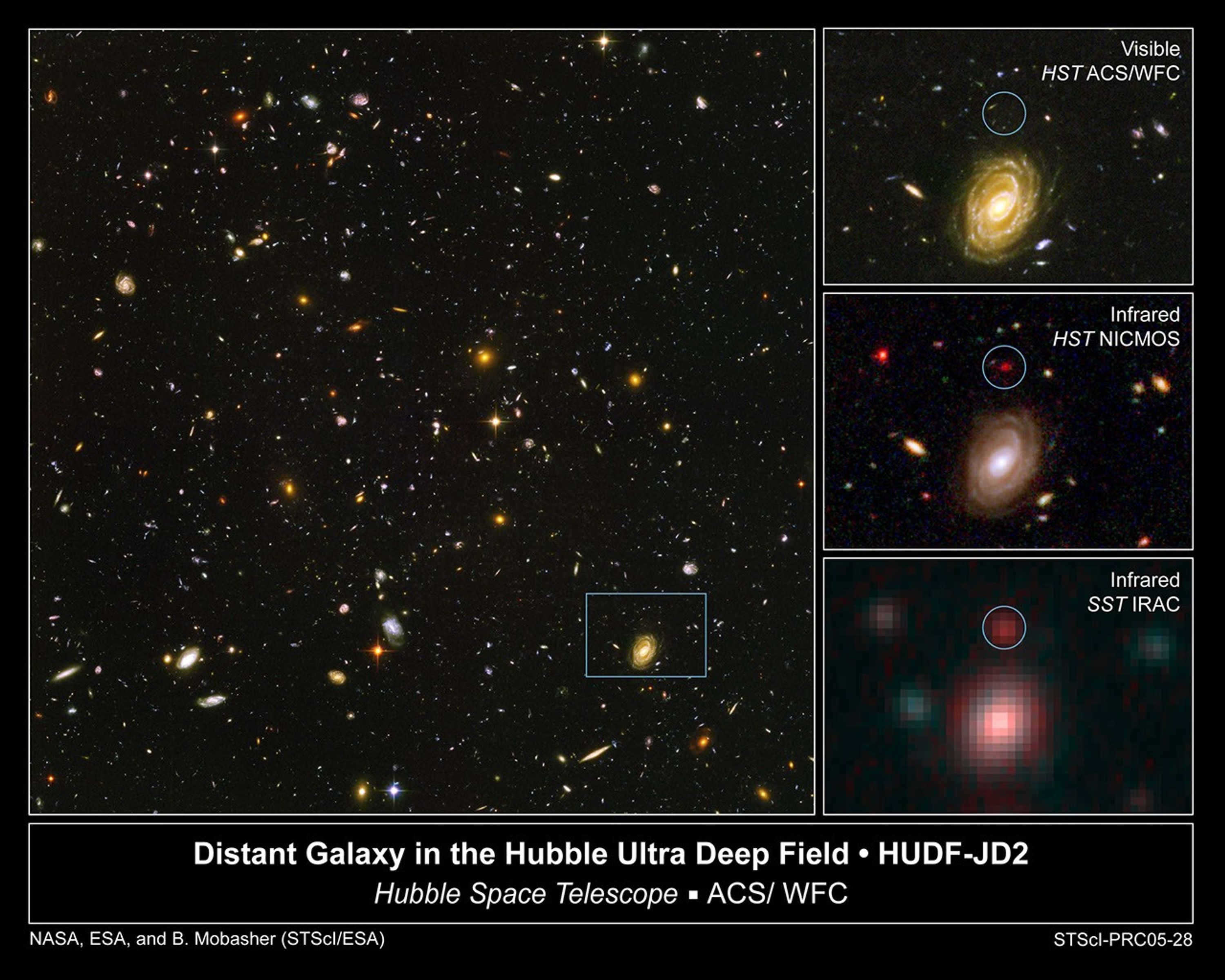1 min read
Galaxy HUDF-JD2 From the Hubble Ultra Deep Field

A blow-up of one small area of the Hubble Ultra Deep Field used to identify where the distant galaxy is located. The galaxy's visible light has been absorbed by traveling billions of light-years through intervening hydrogen.
About the Object
- R.A. PositionR.A. PositionRight ascension – analogous to longitude – is one component of an object's position.3h 32m 28s.74s
- Dec. PositionDec. PositionDeclination – analogous to latitude – is one component of an object's position.-27° 48' 39".9
- ConstellationConstellationOne of 88 recognized regions of the celestial sphere in which the object appears.Fornax
- DistanceDistanceThe physical distance from Earth to the astronomical object. Distances within our solar system are usually measured in Astronomical Units (AU). Distances between stars are usually measured in light-years. Interstellar distances can also be measured in parsecs.This galaxy has a redshift of z = 6.5.
About the Data
- Data DescriptionData DescriptionProposal: A description of the observations, their scientific justification, and the links to the data available in the science archive.
Science Team: The astronomers who planned the observations and analyzed the data. "PI" refers to the Principal Investigator.The HUDF image was created from HST data from proposal 9978: S. Beckwith, S. Malhotra, M. Giavalisco, N. Panagia, J. Rhoads, M. Stiavelli, R. Somerville, S. Casertano, B. Margon, C. Blades, J. Caldwell, and M. Clampin (STScI), M. Corbin (CSC), M. Dickinson, H. Ferguson, and A. Fruchter (STScI), R. Hook (STScI/ECF), S. Jogee, A. Koekemoer, R. Lucas, M. Sosey and L. Bergeron (STScI). The science team for HUDF-JD2 includes: B. Mobasher (STScI/ESA); M. Dickinson (NOAO); H.C. Ferguson and M. Giavalisco (STScI); T. Wiklind (STScI/ESA); D. Stark and R.S. Ellis (Caltech); M. Fall (STScI); N. A. Grogin (JHU); L. Moustakas (STScI); N. Panagia (STScI/ESA); M. Sosey, M. Stiavelli, E. Bergeron, and S. Casertano (STScI); P. Ingram (Gemini Obs.); A. Koekemoer (STScI); I. Labbe (Carnegie Obs.); M. Livio (STScI); B. Rogers (Gemini Obs.); C. Scarlata (Inst. for Astronomy, Zurich, Switzerland); J. Venet, A. Renzini and P. Rosati (ESO); H. Kuntschner, M. Kummel, and J.R. Walsh (STECF/ESO). - InstrumentInstrumentThe science instrument used to produce the data.HST>ACS/WFC
- Exposure DatesExposure DatesThe date(s) that the telescope made its observations and the total exposure time.September 24, 2003 - January 16, 2004, Exposure Time: 11.3 days
- FiltersFiltersThe camera filters that were used in the science observations.F435W (B), F606W (V), F775W (I), F850LP (z)
- Object NameObject NameA name or catalog number that astronomers use to identify an astronomical object.Hubble Ultra Deep Field; HUDF, HUDF-JD2, UDF033238.74-274839.9
- Object DescriptionObject DescriptionThe type of astronomical object.High-Redshift Galaxy in the Hubble Ultra Deep Field
- Release DateSeptember 27, 2005
- Science ReleaseSpitzer and Hubble Team Up to Find “Big Baby” Galaxies in the Newborn Universe
- Credit

Color Info
Color InfoA brief description of the methods used to convert telescope data into the color image being presented.
HUDF Image (left) Blue: F435W (B) Green: F606W (V) + F775W (I) Red: F850LP (z)

Compass and Scale
Compass and ScaleAn astronomical image with a scale that shows how large an object is on the sky, a compass that shows how the object is oriented on the sky, and the filters with which the image was made.
Related Images & Videos

Galaxy HUDF-JD2 in the Hubble Ultra Deep Field
This image demonstrates how data from two of NASA's Great Observatories, the Spitzer and Hubble Space Telescopes, are used to identify one of the most distant galaxies ever seen. This galaxy is unusually massive for its youthful age of 800 million years. (After the Big Bang, the...

Galaxy HUDF-JD2 – Infrared
The Spitzer Infrared Array Camera (IRAC), easily detected the galaxy at longer infrared wavelengths. Spitzer's IRAC is sensitive to the light from older, redder stars which should make up most of the mass in a galaxy. The brightness of the infrared galaxy suggests that it is...
Share
Details
Last Updated
Aug 17, 2025
Contact
Media
Claire Andreoli
NASA’s Goddard Space Flight Center
Greenbelt, Maryland
claire.andreoli@nasa.gov


































